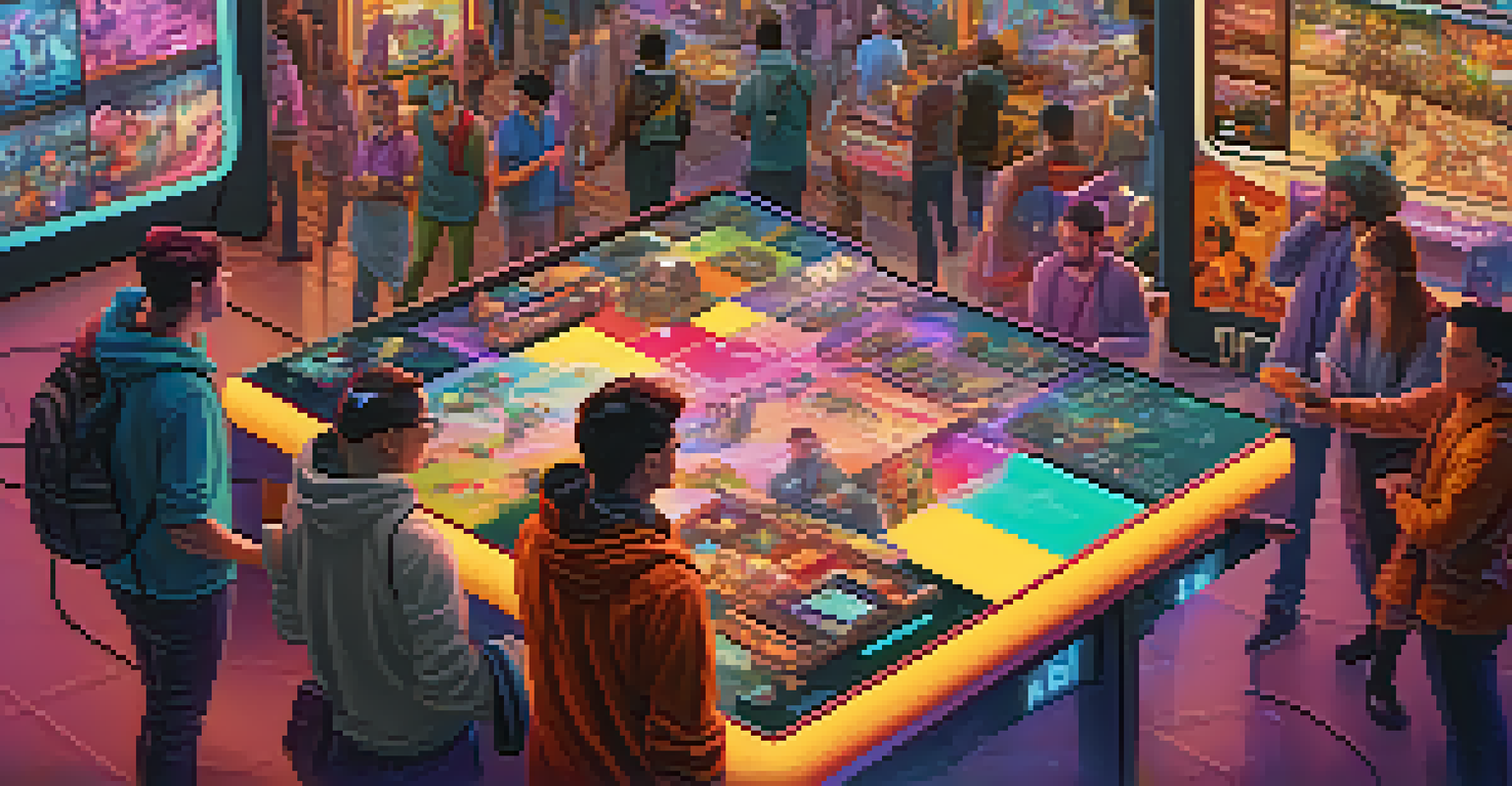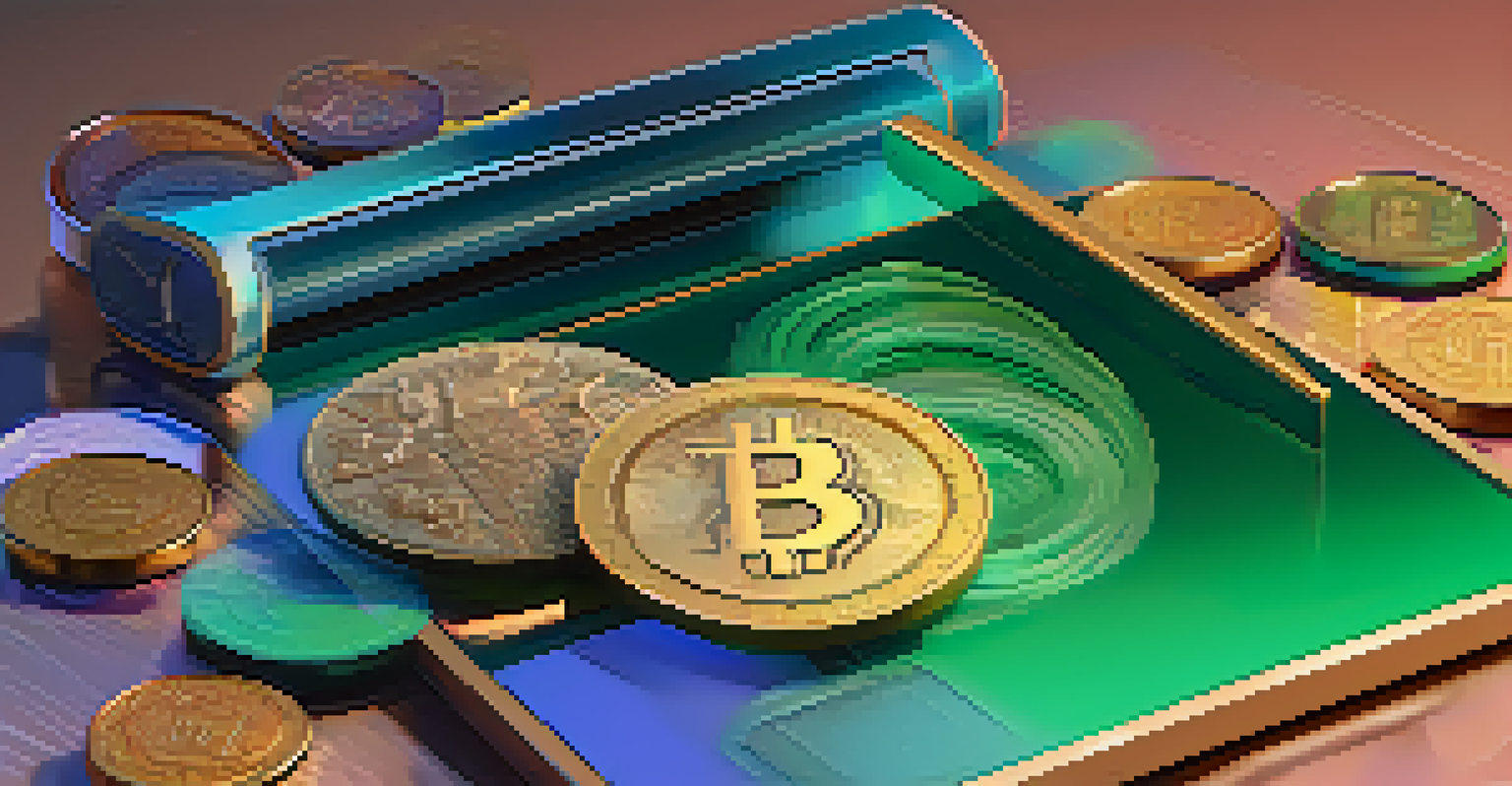NFTs vs. Traditional Game Assets: A Comparative Analysis

Defining NFTs and Traditional Game Assets
NFTs, or Non-Fungible Tokens, are unique digital assets stored on a blockchain, which means they cannot be replicated or exchanged on a one-to-one basis. In contrast, traditional game assets are generally fungible, like coins or skins in a game, which can be easily exchanged or replicated without losing their value. Think of NFTs as rare collectibles, while traditional assets are more like currency that can be freely traded among players.
Ownership is not just about having something; it's about being able to make choices with it.
The uniqueness of NFTs allows players to own one-of-a-kind items, which can increase their value based on demand. For instance, an NFT of a rare weapon in a game may sell for thousands, while traditional game assets like coins hold a set value and can often be earned through gameplay. This distinction leads to different economic models in gaming, where NFTs can create a real-world value that traditional assets typically lack.
Understanding these definitions sets the stage for exploring how these two asset types function within gaming ecosystems. As we dive deeper, we’ll see how ownership, trading, and player interaction differ significantly between NFTs and traditional game assets.
Ownership: The Key to Player Investment
When you purchase a traditional game asset, you're essentially buying a license to use that item within the game, but you don't truly own it. Developers can modify or remove assets at any time, which can lead to frustration among players. On the other hand, owning an NFT gives players true ownership over their digital asset, allowing them to trade or sell it outside the game environment, independently of the game's developers.

This concept of ownership is crucial as it affects how players engage with their gaming experience. For example, if a player invests in an NFT, they might be more likely to play that game consistently, knowing that their investment holds potential value. This creates a more engaged community and can lead to a richer gaming experience overall.
NFTs Enable True Digital Ownership
Unlike traditional game assets, NFTs provide players with genuine ownership of their items, allowing them to trade or sell independently of developers.
Ultimately, the difference in ownership models can influence a player's willingness to invest time and money into a game. As players seek more control over their assets, the appeal of NFTs continues to grow, reshaping the landscape of gaming.
Trading and Market Dynamics in Gaming
The trading dynamics of traditional game assets often operate within a closed system, meaning players can trade items with each other but are largely restricted by the game's economy. This can limit the potential value of items and lead to dissatisfaction among players who feel their assets are undervalued. In contrast, the market for NFTs is more open and decentralized, allowing players to trade items across different platforms and marketplaces.
In a world where everything is interchangeable, uniqueness is a treasure.
For example, a player might buy a rare NFT in one game and later sell it on a different marketplace, potentially realizing a significant profit. This fluidity in trading not only increases the potential value of NFTs but also fosters a vibrant ecosystem where players can monetize their gaming experiences. It’s akin to trading baseball cards—some cards hold immense value based on rarity, while others may be less desirable.
As we continue to explore these market dynamics, it's clear that NFTs have the potential to revolutionize how players interact with game economies. This shift opens up new opportunities for monetization and investment, making gaming a more lucrative endeavor.
The Role of Scarcity in Value Creation
Scarcity plays a pivotal role in determining the value of any asset, whether it's traditional or digital. In the realm of traditional game assets, scarcity is often artificially created by the developers, who might limit the availability of certain items or skins. However, with NFTs, scarcity is built into the very fabric of their existence—each token is unique and verifiable on the blockchain, ensuring that no two NFTs are exactly alike.
This inherent scarcity can drive player demand, much like limited edition collectibles in the real world, such as rare coins or vintage toys. When players know that an NFT is one-of-a-kind, they may be more inclined to invest heavily in it. This creates a sense of urgency and excitement around acquiring rare items, which can result in significant price hikes.
Market Dynamics Favor NFTs
The open and decentralized nature of NFT trading creates a vibrant ecosystem, enabling players to realize significant profits through their digital assets.
As we analyze the impact of scarcity on asset value, it becomes evident that NFTs can create a more dynamic and engaging market. Players are not just buying items; they are investing in unique pieces of art and culture, which can lead to a deeper emotional connection to the game.
Game Developer Control and Community Impact
In traditional gaming, developers maintain control over game assets, balancing the economy and making adjustments as needed. This centralized approach can sometimes lead to player dissatisfaction, especially if items are nerfed or removed. In contrast, NFTs empower players by giving them control over their assets, allowing them to dictate their own value and usage within the gaming ecosystem.
This shift in control can foster a stronger sense of community among players, as they collectively influence the market for NFTs. For instance, if a certain NFT becomes highly sought after, players may collaborate to promote its value, creating a buzz that fuels further interest. This community-driven approach contrasts with the often top-down control seen in traditional game asset markets.
Ultimately, the change in control dynamics can lead to richer player engagement and a more vibrant gaming community. As NFTs continue to gain traction, developers may need to adapt their strategies to accommodate this new model of player ownership.
Challenges and Risks of NFTs in Gaming
While NFTs offer exciting opportunities, they also come with unique challenges and risks. For instance, the volatility of the NFT market can lead to significant price fluctuations, leaving players vulnerable to potential losses. This unpredictability can be daunting for players who may not fully understand the implications of investing in NFTs compared to traditional game assets.
Additionally, the environmental impact of blockchain technology used to mint NFTs has raised concerns among players and developers alike. The energy consumption associated with some blockchain networks poses ethical questions that need to be addressed as the gaming community embraces NFTs. Developers are increasingly seeking eco-friendly alternatives, but the conversation around sustainability remains critical.
Hybrid Model May Shape Future Gaming
The future of gaming assets could blend NFTs and traditional assets, offering players flexibility in how they engage with games.
As we weigh the potential benefits against the risks, it's essential for players to approach NFTs with caution and an understanding of the broader landscape. Being informed can help players navigate these challenges and make more educated decisions about their investments.
The Future of Gaming Assets: A Hybrid Approach?
Looking ahead, the future of gaming assets may not be a strict divide between NFTs and traditional assets but rather a hybrid approach that combines the best of both worlds. Developers could create games that incorporate NFTs while still offering traditional assets, allowing players to choose their preferred method of engagement. This could lead to a more inclusive gaming environment that caters to a wider audience.
For instance, casual players may prefer the simplicity of traditional assets, while more invested players might gravitate towards NFTs for their unique ownership opportunities. By offering both options, developers can create a richer experience that appeals to a diverse player base, ultimately driving engagement and investment in their games.

As we explore this potential future, it's clear that innovation will play a crucial role in shaping the gaming landscape. The convergence of NFTs and traditional game assets could redefine how we think about ownership, value, and community in gaming.